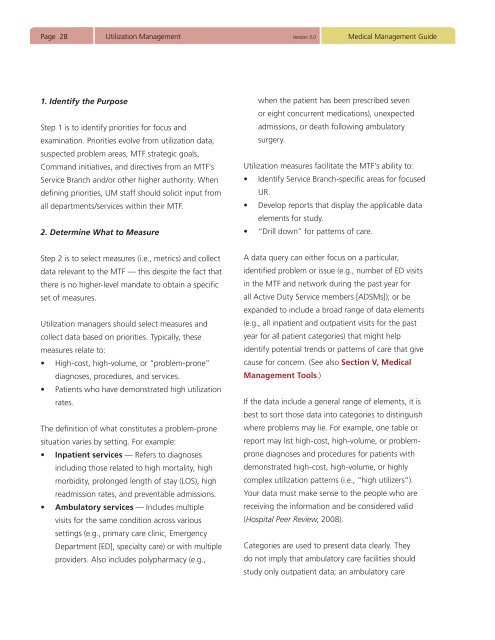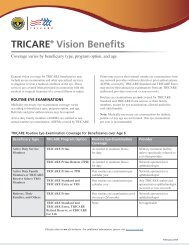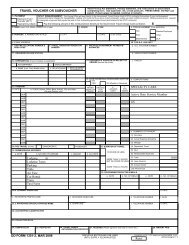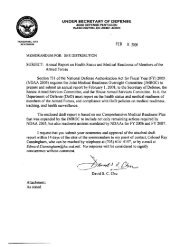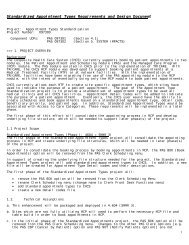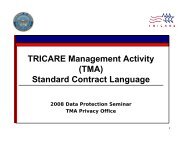Medical Management Guide, 2009, Version 3.0 - Tricare
Medical Management Guide, 2009, Version 3.0 - Tricare
Medical Management Guide, 2009, Version 3.0 - Tricare
- No tags were found...
You also want an ePaper? Increase the reach of your titles
YUMPU automatically turns print PDFs into web optimized ePapers that Google loves.
Page 28Utilization <strong>Management</strong> <strong>Version</strong> <strong>3.0</strong><strong>Medical</strong> <strong>Management</strong> <strong>Guide</strong>1. Identify the PurposeStep 1 is to identify priorities for focus andexamination. Priorities evolve from utilization data,suspected problem areas, MTF strategic goals,Command initiatives, and directives from an MTF’sService Branch and/or other higher authority. Whendefining priorities, UM staff should solicit input fromall departments/services within their MTF.2. Determine What to Measurewhen the patient has been prescribed sevenor eight concurrent medications), unexpectedadmissions, or death following ambulatorysurgery.Utilization measures facilitate the MTF’s ability to:• Identify Service Branch-specific areas for focusedUR.• Develop reports that display the applicable dataelements for study.• “Drill down” for patterns of care.Step 2 is to select measures (i.e., metrics) and collectdata relevant to the MTF — this despite the fact thatthere is no higher-level mandate to obtain a specificset of measures.Utilization managers should select measures andcollect data based on priorities. Typically, thesemeasures relate to:• High-cost, high-volume, or “problem-prone”diagnoses, procedures, and services.• Patients who have demonstrated high utilizationrates.The definition of what constitutes a problem-pronesituation varies by setting. For example:• Inpatient services — Refers to diagnosesincluding those related to high mortality, highmorbidity, prolonged length of stay (LOS), highreadmission rates, and preventable admissions.• Ambulatory services — Includes multiplevisits for the same condition across varioussettings (e.g., primary care clinic, EmergencyDepartment [ED], specialty care) or with multipleproviders. Also includes polypharmacy (e.g.,A data query can either focus on a particular,identified problem or issue (e.g., number of ED visitsin the MTF and network during the past year forall Active Duty Service members [ADSMs]); or beexpanded to include a broad range of data elements(e.g., all inpatient and outpatient visits for the pastyear for all patient categories) that might helpidentify potential trends or patterns of care that givecause for concern. (See also Section V, <strong>Medical</strong><strong>Management</strong> Tools.)If the data include a general range of elements, it isbest to sort those data into categories to distinguishwhere problems may lie. For example, one table orreport may list high-cost, high-volume, or problempronediagnoses and procedures for patients withdemonstrated high-cost, high-volume, or highlycomplex utilization patterns (i.e., “high utilizers”).Your data must make sense to the people who arereceiving the information and be considered valid(Hospital Peer Review, 2008).Categories are used to present data clearly. Theydo not imply that ambulatory care facilities shouldstudy only outpatient data; an ambulatory care


